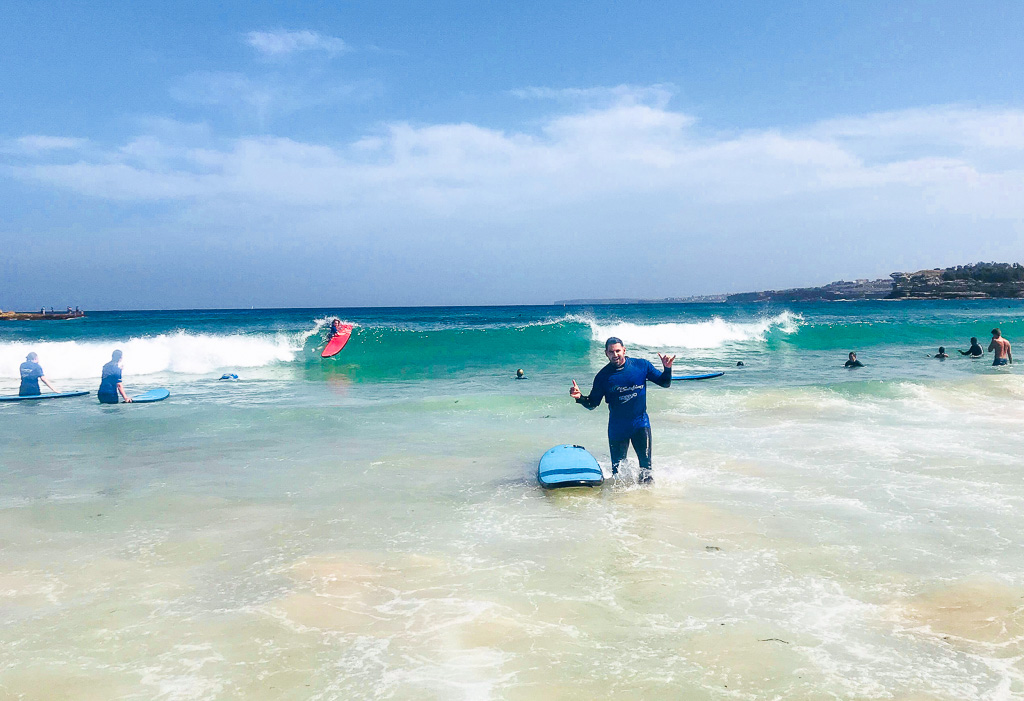
Surfing for the first time at 38 years old? Why not. I have always wanted to learn how to surf since it combines being out on the water with activity on the waves. And what better place to learn how to surf other than infamous Bondi Beach just east of Sydney, Australia.
I decided to use Let’s Go Surfing company for my lesson and booked a package of three, 2-hour lessons. My thinking was that the first session will be learning and the second two sessions will be practicing! Mine sessions were all group lessons but you can also book a private lesson. The booking times were two hour blocks throughout the day and you can book online.
They provided the following:
- Wet suit
- Rash shirt
- Sunscreen
- Zinc to make sure the sunscreen stayed
- Surf board (of course)
The instructors were great. Before we began the session, we took a moment to briefly get to know the other people in the group. Then the instructor explained how waves work and what to do if caught in a rip current. And we did some basic motions on the beach of how to stand up on the board. This took about 15 minutes.
Then it was time to go out on the waves to surf. It looks much easier than it looks to get up and balance your body on the board. It is easier if you have skateboarded or snowboarded before. I had never done either but managed to get up several times during my first lesson for 3-4 seconds. Here are the top challenges I faced during my lesson:
- Choosing which wave to pick: bigger isn’t always better. This is probably one of the most difficult challenges when learning to surf. Pick a smaller wave when you are learning.
- Starting to paddle before the wave arrives. Timing is the most important element. This is tricky as you must be laying down on the board and you paddle hard to ensure the board is going the same speed of the wave.
- Pushing your body up with your hands. Its not only the act of pushing up but its also when to time the motion. Once you feel the board being pushed by the wave, it is time to push your body up from the board.
- Standing up in a balanced way on the moving board. This is the second most challenging piece of surfing. The board is moving and you are trying to now stand up onto the board while keeping the board flat (and not shifting it side to side). Even doing this in calm water is a challenge.
- Balancing your body once you are up on the board. Now that your body is up onto the board you must position your feet perpendicular to the long part of the board in the center. And you must stay low by bending your knees to ensure proper balance. Not as easy as it looks!
- Adjusting your position on the board if needed. And lastly, if your feet aren’t positioned in the center of the board, you must adjust them in real time as the board is moving.
The one thing I am glad the instructor reminded the entire group before we started surfing was to have patience and not get frustrated. I found that with this positive attitude that I was able to overcome falling down and getting back out there to try again.
But go with a relaxed mind and not expecting too much. I found the entire two hours very meditative. The only focus I had for the time was on surfing and that was all. Nothing else.
Of course its probably easier to learn how to surf at an earlier age but don’t be afraid of trying it at any age. Once you get up, you want to keep trying again. And it’s great to be out in the water on a hot day just taking everything in!
Did you learn how to surf later in life? Share your story below with a comment!


